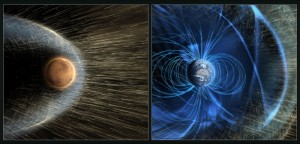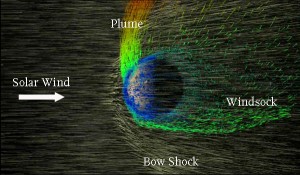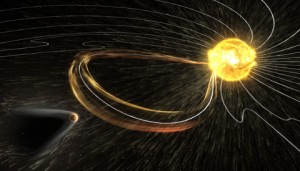NASA’s Mars orbiter MAVEN has painted a detailed picture of how the solar wind robs the Red Planet of its atmosphere.

NASA / GSFC
Mars “died” billions of years ago. Ancient Mars had rivers and lakes, but today the cold, desolate planet’s whiff of an atmosphere is so thin that the surface pressure is a mere hundredth that at Earth’s sea level — water will freeze or evaporate away in those conditions.
A primary theory for where all that atmosphere went is that the solar wind blew it away. The solar wind is a river of charged particles that flows out from the Sun, carrying with them the solar magnetic field. All the planets plow through this flow as they orbit our star. For Earth, it doesn’t pose a huge problem: our planet’s relatively strong magnetic field holds the wind mostly at bay. But Mars lost its global field more than 4 billion years ago, so the solar wind smacks directly into its upper atmosphere.
The main objective of NASA’s MAVEN mission is to monitor this interaction. The hope is that, by watching today’s atmospheric gas leave, scientists can figure out what happened 4 billion years ago.
The spacecraft follows an elongated orbit that dips into Mars’s upper atmosphere at its closest approach. As it flies, MAVEN records conditions in its immediate environment, including the velocities and composition of charged particles arriving at and leaving the planet.
After analyzing the first six to seven months of mission data, principal investigator Bruce Jakosky (University of Colorado, Boulder) and his team have built a cohesive picture of where gas in the upper atmosphere is going. They found that it leaves the planet three ways: in a polar plume, as a downwind tail, and from an extended cloud of gas surrounding the entire planet. Combined, the effect looks like this:
Leaking Atmosphere

NASA / Greg Shirah, labels by S&T
The team first reported that Mars sports a Mohawk-esque polar plume soon after the spacecraft arrived at the end of 2014. This plume, driven from the pole on the planet’s dayside, is a stream of ions caught up in an electric field that’s created by the changing direction of the solar magnetic field as it blows into Mars’s upper atmosphere. (Electricity & Magnetism 101: a changing magnetic field creates an electric field, and vice versa.) Because linked magnetic and electric fields are perpendicular to each other, the plume is directed up from the pole, instead of following the flow of the solar wind. About 25% of the atmosphere lost leaves via this route.
The second, and predominant, exit ramp is the windsock tail streaming behind Mars’s nightside. The tail forms as the solar wind hits the upper atmosphere and is deflected around the planet, just like air bends into a bow shock around a supersonic jet. The atmospheric ions caught up in this flow don’t move as fast as the plume ones, but there are a whole lot more of them: the team estimates that 75% of the atmosphere lost leaves through the solar wind tail.
A smattering of gas escapes from the top of the atmosphere as neutral atoms, creating a tenuous corona far from the planet’s dayside. Once these atoms become ionized, the solar wind drives them back toward Mars and into the interplanetary depths beyond.
Adding up all these losses, the scientists find that, globally, Mars is losing a few trillion trillion (1024) atoms per second. That translates into about 100 grams, or a quarter pound. “I can’t help but imagine hamburgers flying out of Mars, once per second,” jokes mission co-investigator Dave Brain (University of Colorado, Boulder).
That’s a lower limit to the amount being lost, because the team only analyzed ions of oxygen, molecular oxygen, and carbon dioxide; they’ve left out low-energy ions and neutral particles for now. This rate of escape could theoretically remove Mars’s current atmosphere in a couple billion years, if nothing replenishes it, Jakosky noted in a press conference on November 5th.
The Great Escape

Credit: NASA/GSFC
But Mars can lose atmosphere a lot faster than that. This past March, the Sun unleashed a huge bubble of plasma called a coronal mass ejection that howled through the solar system like a gale and slammed into the Red Planet. The force compressed the bow shock around Mars to two thirds its usual size, exposing more of the atmosphere to the magnetic and electric fields that strip gas away. Escape rates during this event spiked by a factor of 10 to 20.
That’s important, because scientists think that the young Sun was far more active than the middle-aged star we live with now. Mars lost its global magnetic field during the time of this heightened activity. In addition, a thicker atmosphere would have puffed up higher above the Martian surface, providing a bigger target for the solar wind to hit, “like a boat’s sail catching the wind as you unfurl it,” explains team member Jasper Halekas (University of Iowa). On the other hand, loading up the fields streaming by Mars with more particles might bog things down, and there might be feedback going on, too, so the exact effect will be complicated to tease out.
The team hasn’t yet done this extrapolating to determine what escape rates were in the distant past. But Mars potentially lost as much atmosphere as Earth has now, so the rate might have to be 100 to 1,000 times greater in that early period, Jakosky speculates.
The MAVEN scientists also don’t know what role Mars’s crustal magnetic fields play. Although the planet lost its global field, vestiges remain as local bubbles frozen in the crust, generally in the southern hemisphere. Brain says he’s working to decipher this information from the data now.
Dust and Aurora
These results are detailed in several papers in the November 6th Science and a special issue of Geophysical Research Letters. Some of these describe the high-altitude dust and aurora detections I blogged about earlier this year. The mysterious dust floats several hundred kilometers up in the atmosphere, far beyond where any physical process would launch it from the surface. MAVEN’s measurements now suggest pretty strongly that this dust comes from interplanetary space, but not from the planet’s two small moons — it’s all over the daytime sky, and not just in the moons’ orbital plane. It’s probably from comets (nope, not particularly from Siding Spring, which skimmed past Mars in October 2014). Other planets get dusty going through the solar system, too, so this result isn’t unexpected.
In addition to the auroras seen across Mars’s northern hemisphere last year, more popped up during the big solar event in March. Auroras come in multiple flavors, such as “discrete” ones, like we see confined to auroral ovals over Earth’s poles, or “diffuse” ones, which are what they sound like — spread out.
But discrete auroras can only happen on Mars where the local crustal fields exist. Otherwise, the high-energy particles spewed from the Sun can follow the solar wind’s magnetic field as it drapes around the planet and impinge essentially wherever they like in the Martian atmosphere, creating continent-size, diffuse aurora. It’s unclear whether we could actually see these auroras with our eyes — MAVEN detects them at ultraviolet wavelengths. But this kind of aurora is potentially common on Mars.
MAVEN’s nominal, 1-year mission ends mid-month, but NASA managers have granted a mission extension. Analysis of the full year’s data should hopefully come out early 2016.
Learn more about Mars with Sky & Telescope's special issue Mars: Mysteries and Marvels of the Red Planet.
 2
2









Comments
Robert-Casey
November 9, 2015 at 4:09 pm
Earth's magnetic field helps protect its atmosphere, and Mars lack of one let its atmosphere get away. But Venus doesn't have a magnetic field, but it still has quite a thick atmosphere. Yes, Venus is bigger and more massive, but it's also closer to the Sun.
You must be logged in to post a comment.
Lou
November 10, 2015 at 9:45 am
Solar UV creates an ionosphere around Venus that deflects some of the solar wind. Additionally, Jeans Escape is less of an issue due to the gravity of Venus compared to Mars.
You must be logged in to post a comment.
You must be logged in to post a comment.